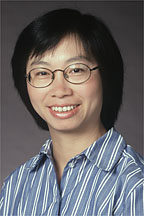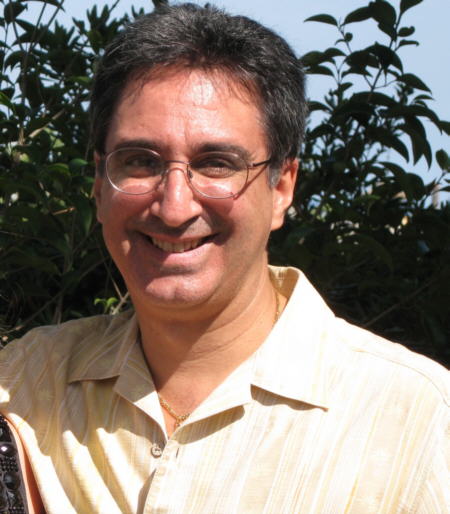![]()
![]()
Keynote Speakers

Weihua Zhuang (IEEE/CAE Fellow)
Professor and Tier I Canada Research Chair in Wireless Communication Networks
University of Waterloo, Canada
Talk Title:
Vehicular Communications: Challenges and Opportunities
Time: 8:30-9:30AM, Tuesday, Jan. 31, 2012
Abstract:
Vehicular ad hoc networks (VANETs) aim at providing communications among nearby vehicles, and between vehicles and nearby roadside equipment, with very limited or no infrastructure support. VANETs are envisioned to be a cornerstone for road safety, intelligent transportation, mobile Internet access, and many location dependent commercial applications. The growing importance of inter-vehicular communications has been recognized by governments, academia, and industry. In comparison with general-purpose mobile ad hoc networks, VANETs have unique features that provide opportunities for optimizations, but also have complex aspects that challenge the system design and implementation, such as very fast network topology changes due to high vehicle speed. This presentation will provide an overview of the state-of-the-art in the development of VANETs, discuss research challenges, and provide some solutions to resource allocation, network control, and service provisioning in VANETs.
Biography:
Weihua Zhuang has been with the Department of Electrical and Computer Engineering, University of Waterloo, Canada, since 1993, where she is a Professor and a Tier I Canada Research Chair in Wireless Communication Networks. Her current research focuses on resource allocation and QoS provisioning in wireless networks.
Dr. Zhuang is a co-recipient of the Best Paper Awards from the IEEE Multimedia Communications Technical Committee in 2011, IEEE Vehicular Technology Conference (VTC) Fall 2010, IEEE Wireless Communications and Networking Conference (WCNC) 2007 and 2010, IEEE International Conference on Communications (ICC) 2007, and the International Conference on Heterogeneous Networking for Quality, Reliability, Security and Robustness (QShine) 2007 and 2008. She received the Outstanding Performance Award 4 times since 2005 from the University of Waterloo, and the Premier's Research Excellence Award in 2001 from the Ontario Government.
Dr. Zhuang is the Editor-in-Chief of IEEE Transactions on Vehicular Technology, and the Technical Program Symposia Chair of the IEEE Globecom 2011. She is a Fellow of the Canadian Academy of Engineering (CAE), a Fellow of the IEEE, and an IEEE Communications Society Distinguished Lecturer.
For more information, please visit http://bbcr.uwaterloo.ca/~wzhuang

Renato Recio (IBM Fellow)
CTO, System Networking
IBM, USA
Talk Title:
The Coming Decade of Data Center Networking Discontinuities (download slides in PDF)
Time: 8:30-9:30AM, Wednesday, Feb. 1, 2012
Abstract:
The traditional Data Center Networking (DCN) model is under a transitory period, where several emerging technologies may cause significant discontinuities and result in a new dominant model. This presentation will cover the client requirements that are influencing the demand side of these new solutions, as well as some of the emerging technologies.
The characteristics of traditional Data Center Networks include: tier based scaling, which relies on adding tiers of switches as port count requirements increase; repetitive network processing at each tier in the topology; the use of dedicated fabrics (e.g. communication, storage, management, clustering), which in some cases were created with one specific role in mind; and the management of many, independent switches, which increases management complexity.
This presentation will provide an overview of several emerging technologies that are vying for a disruptive position in Data Centers. Network flattening technologies seek a significant tier and switch reduction, each of these technologies comes with its own set of challenges -- examples include Cisco’s VNTag based fabric extenders and Juniper’s QFabric. Several technologies are also emerging that redistribute network intelligence; eliminate unnecessary, repetitive processing; and reduce the number of managed switches -- examples include layer-3 Distributed Overlay Virtual Ethernet (DOVE) switches, OpenFlow and even network flattening architectures. These too face their own set of adoption challenges. Finally, fabric convergence has been well underway in the Data Center, but care must be taken to fully satisfy Enterprise requirements, such as disjoint multipathing.
Biography:
Renato Recio is IBM Fellow & System Networking CTO, specializing in System I/O and Network Architecture, Strategy, and Standards. For the past 14 years, he has played a leadership role in the strategy, architecture and design of future IBM system IO and Networks. He is currently responsible for cross-IBM Data Center and Virtual Switch Networking product strategy and roadmap.
He has been a founding engineer and author of several IO and Network industry standards, including: InfiniBand (cluster network), iWARP (Remote Direct Memory Access, RDMA, over TCP/IP), PCI IO Virtualization, Convergence Enhanced Ethernet (CEE), Fibre Channel over CEE and IEEE 802.1Qbg Ethernet Virtual Bridging. He also created and chaired IBM’s I/O Technical Community (IOTC), which serves the networking, education, and support needs of over 750 IBM IO and networking professionals. He has received 4 external, professional awards for his contributions to the industry, including a Life Time Achievement Award in recognition for his contributions to Server IO field.
He has filed 187 patents, of which over 100 have already issued. He has published dozens of refereed technical conference (e.g. IEEE and ACM) papers. He created and chairs the IEEE Data Center Converged And Virtual Ethernet Switching (DC CAVES) workshops (see www.i-teletraffic.org/itc22/workshops/dc-caves-workshop/).

Muriel Medard (IEEE Fellow)
Professor, MIT, USA
Talk Title:
When Coding Met Video QoE
Time: 8:30-9:30AM, Thursday, Feb. 2, 2012
Abstract:
We present some approaches that illustrate how network coding can improve QoE. The notion of QoE itself is highly dependent on application-specific user experience expectations. We first consider QoE as a probability of interruption of video, and show that coding can be used to reduce the probability of interruption, with a behavior akin to error exponents. We apply these principle to stitch effectively cellular networks with 802.11 in order to obtain very low probability of interruption while accessing almost exclusively the 802.11 network. The second QoE measure we consider is high, reliable rate under wireless losses. We show how network coding can avoid interruptions in TCP/IP, by coding over temporary network effects that can lead to significant service interruptions. Finally, we consider a third type of QoE, which is the ability to share socially video in a proximity-based network. The QoE in this case if to provide a seamless social viewing experience over heterogeneous devices. We use network coding in a peer-to-peer proximate network to achieve this QoE.
Joint work with
Minji Kim, Marie-José Montpetit, Asuman Ozdaglar, Ali ParandehGheibi, Chris Ng, Michael Mitzenmacher, Jay-Kumar Sundararajan, Frank Fitzek, Janus Heide,Morten Pedersen, Joao Barros, Luisa Lima, Joao Paulo Vilela, Michael Heindlmaier, Ashutosh Kulkarni, Danail Traskov, Srinivas Shakkottai.
Biography:
Muriel Médard
is a Professor of Electrical Engineering at MIT. She was previously an
Assistant Professor in the ECE Department at UIUC and a Staff Member at MIT
Lincoln Laboratory. She received B.S. degrees in EECS, in Mathematics, and in
Humanities, as well as M.S. and Sc D. degrees in EE,
all from MIT. She has served as an Associate Editor for the Optical
Communications and Networking Series of the IEEE Journal on Selected Areas in
Communications, the IEEE Transactions on Information Theory and the OSA Journal
of Optical Networking. She has served as a Guest Editor for the IEEE Journal of
Lightwave Technology, the IEEE Transactions on
Information Theory (twice), the IEEE Journal on Selected Areas in
Communications and the IEEE Transactions on Information Forensic and Security.
She serves as an associate editor for the IEEE/OSA Journal of Lightwave Technology. She is a member of the Board of
Governors of the IEEE Information Theory Society and currently serves as First
Vice-President. She has served as TPC co-chair of ISIT, WiOpt
and CONEXT. She was awarded the 2009 IEEE Communication Society and Information
Theory Society Joint Paper Award , the 2009 IEEE
William R. Bennett Prize in the Field of Communications, and the 2002 IEEE Leon
K. Kirchmayer Prize Paper Award. She was co-winner of
the 2004 MIT Harold E. Edgerton Faculty Achievement Award. In 2007, she was
named a Gilbreth Lecturer by the National Academy of
Engineering. She serves as the first Vice-President of the Information Theory
Society. Professor Médard's research interests are in
the areas of network coding and reliable communications, particularly for
optical and wireless networks.